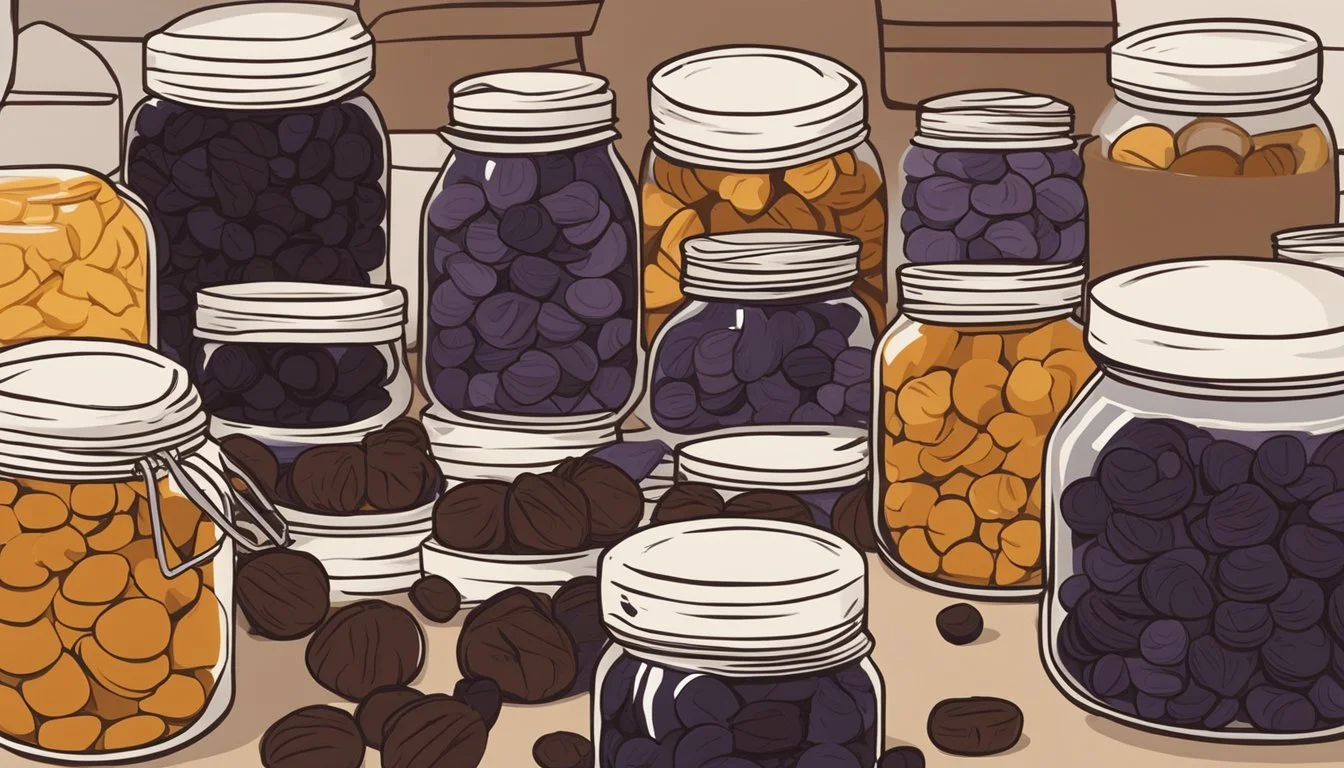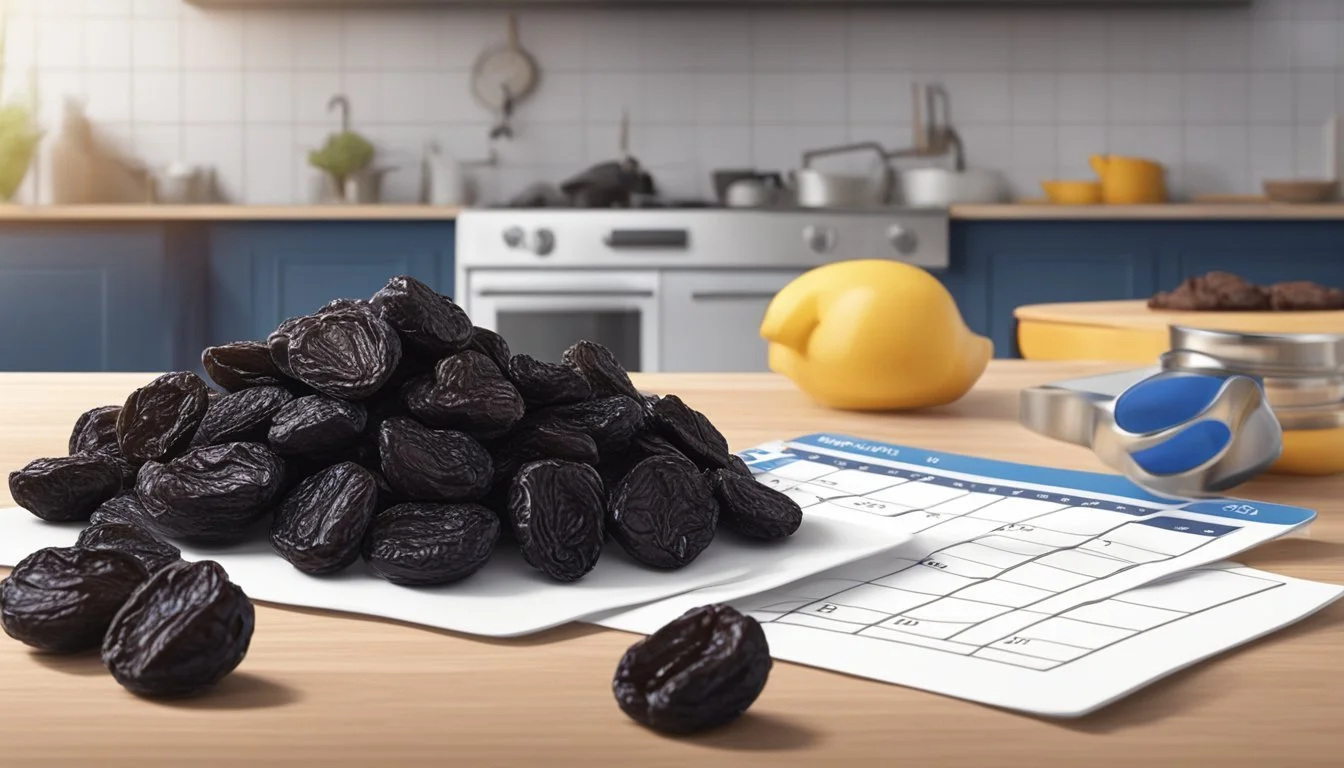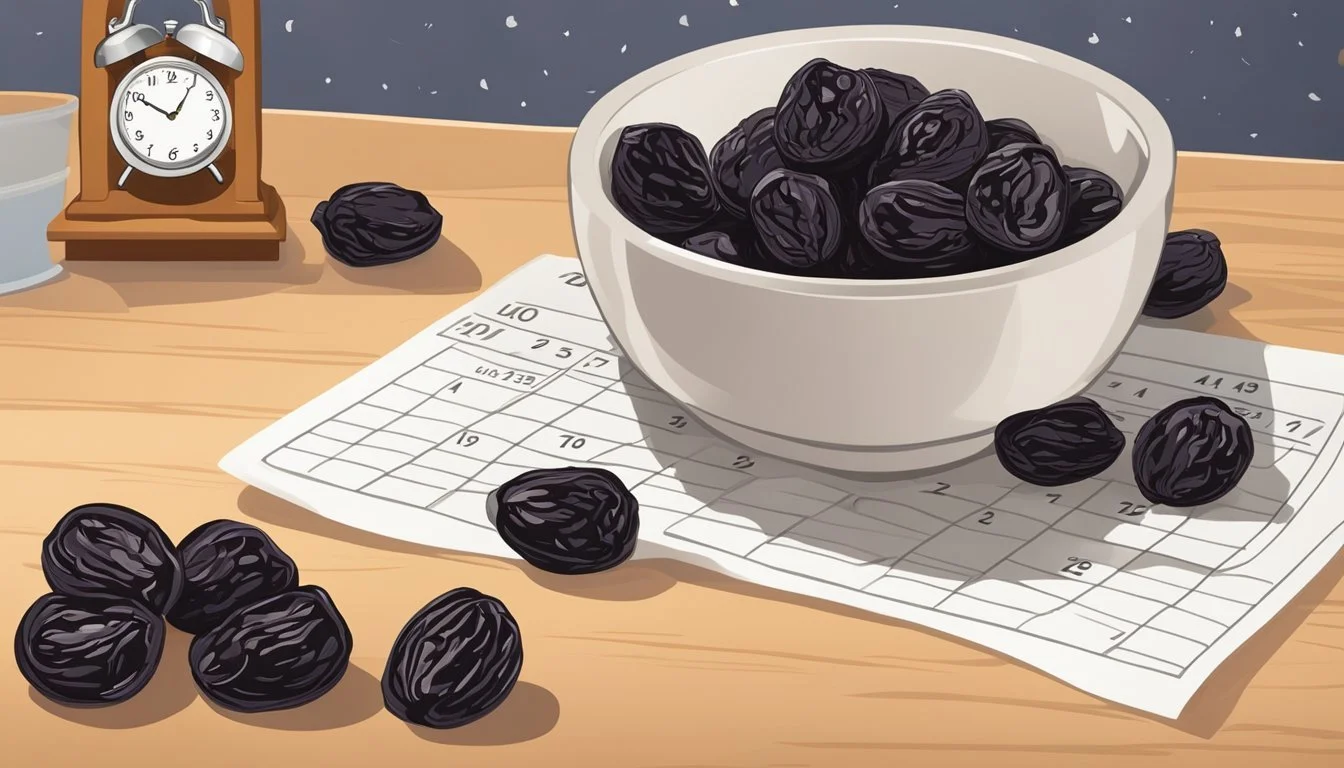How Long Do Dried Prunes Last?
Shelf Life and Storage Tips
Dried prunes, known for their sweet flavor and chewy texture, are a popular snack and a staple in many pantries. Their shelf life is considerably longer than that of fresh fruit due to the removal of moisture which inhibits microbial growth, a critical factor leading to spoilage. Under optimal storage conditions, dried prunes can maintain top quality in the pantry for up to six months in their unopened original packaging.
Once the package is opened, the prunes are exposed to the environment that can accelerate deterioration. However, if they are stored properly in a tightly sealed container, they can still retain their quality for up to six additional months when kept in the refrigerator. It is also essential to note that improper storage conditions such as heat and moisture can decrease their shelf life and lead to spoilage, characterized by mold, discoloration, or an unusual odor.
For long-term storage beyond six months, freezing the prunes may be considered. Although freezing can extend their shelf life, the texture and flavor of the prunes might be affected upon thawing. Therefore, it's advisable for consumers to evaluate whether the change in texture and flavor post-freezing aligns with their intended use of the prunes.
Understanding Dried Prunes
Dried prunes, often referred to as dried plums, offer a multitude of nutritional benefits and health advantages. This section delves into the specific nutritional content of dried prunes and the various health benefits they provide.
Nutritional Value
Dried prunes are a rich source of essential nutrients. They are high in dietary fiber, which is beneficial for digestive health. A notable component of prunes is their antioxidant content, including phenolic compounds that help in reducing oxidative stress. These dried fruits provide a variety of vitamins and minerals, including vitamin K, which is crucial for proper blood clotting and bone health. They also contain potassium for cardiovascular health, copper for red blood cell formation, and magnesium, which is involved in numerous biochemical reactions in the body.
Nutrient Benefit Fiber Supports digestive health Antioxidants Reduces oxidative stress Vitamin K Aids in blood clotting and bone health Potassium Crucial for cardiovascular health Copper Essential for red blood cells Magnesium Important for metabolic reactions
Health Benefits
Consuming dried prunes can have positive effects on overall health. Their high fiber content aids in maintaining a healthy digestive system, potentially preventing constipation. Prunes' antioxidants play a role in battling free radicals, which can prevent cell damage. Regular consumption of prunes may also contribute to improved cardiovascular health by helping to raise "good" HDL cholesterol levels and lowering the ratio of total cholesterol to HDL cholesterol. Additionally, the potassium in prunes helps to manage blood pressure levels, while magnesium supports muscle and nerve function.
Proper Storage Conditions
For dried prunes to retain their quality and extend their shelf life, it's essential to control exposure to air, moisture, and temperature. Using appropriate storage methods in the pantry, refrigerator, or freezer can prevent spoilage and maintain flavor.
In the Pantry
Dried prunes should be stored in airtight containers or resealable plastic bags to prevent moisture from affecting their texture. Room temperature in a cool, dry place away from direct sunlight is the ideal condition for pantry storage. Under these circumstances, prunes can maintain their quality for up to 6 months.
In the Refrigerator
If the prunes have been cooked or if the climate is especially warm, storing them in the refrigerator within airtight containers can help preserve their freshness. When refrigerated, prunes can last for about 2 weeks. Ensure that the temperature is consistent to avoid any moisture buildup that could lead to spoilage.
In the Freezer
Freezing prunes can extend their shelf life up to 6 months; however, this can alter their texture and flavor. Prunes should be placed in airtight containers or heavy-duty freezer bags to protect against freezer burn. It is important to note that although freezing can preserve them for longer, the thawed product might have a slight change in quality.
Shelf Life and Spoilage
The shelf life of dried prunes varies depending on storage conditions, but they generally maintain quality for 6 to 12 months. Recognizing spoilage is essential to ensure prunes are safe for consumption.
Factors Affecting Shelf Life
Storage Conditions: Dried prunes typically last:
Pantry (Unopened): 6 to 12 months at top quality
Pantry (Opened): Up to 6 months if stored properly
Refrigerator (Cooked or opened): Up to 1 year to maintain quality
Freezer: 18-24 months, though it may affect texture and flavor
Environmental Factors:
Temperature: A cool, dry place preserves their quality.
Humidity: Excess moisture can lead to spoilage.
Exposure to Air: Oxygen can accelerate degradation.
Packaging:
Original, unopened packaging helps prunes last longer.
After opening, an airtight container is ideal.
Signs of Spoilage
Mold: Visible signs of mold indicate spoilage.
Discoloration: Any changes from their normal dark color.
Off Smell: An abnormal or sour odor can signal spoilage.
Texture: They should remain relatively soft; excessive hardness can be a sign of age.
Flavor: A noticeable change from their typical sweet taste suggests they may no longer be good to eat.
It's important to inspect prunes for these signs before consumption to avoid the potential health risks of spoiled food, which can harbor harmful bacteria.
Extending Shelf Life
Proper storage methods are essential for extending the shelf life of dried prunes. Attention to moisture control, temperature management, and appropriate packaging will substantially increase their longevity.
Moisture Control
To prevent spoilage due to excess humidity, dried prunes should be kept in an airtight container. This limits exposure to air and moisture, which are prime contributors to the deterioration of the fruit.
Temperature Management
The storage temperature plays a crucial role in preserving the quality of dried prunes. It's best to store prunes at a cool room temperature, ideally between 60°F (15°C) and 70°F (21°C). For a longer shelf life, one can refrigerate the prunes. However, to avoid issues like freezer burn, it is not advisable to store prunes in the freezer unless necessary.
Packaging
Effective packaging is vital to maintain freshness and extend the shelf life of dried prunes. Prunes should be sealed properly after each use to minimize exposure to the elements. Utilizing vacuum-sealed bags or containers with tight-fitting lids can help in maintaining the prune's quality over time.
Utilizing Dried Prunes
Dried prunes offer versatility in the kitchen and can enhance both the nutritional value and flavor profile of many dishes.
In Cooking and Baking
Prunes have a deep, rich flavor that complements a variety of recipes. In cooking, they can be stewed and served with meats, elevating dishes such as tagines with their sweet yet tangy essence. Prunes also pair well with breakfast items; chopped prunes can be added to cereal, oatmeal, or yogurt to start the day with a nutritional boost. When it comes to baking, prunes can serve as a natural sweetener and add moisture to baked goods. They are especially popular in muffins, bread, and cakes. For a healthy twist, prunes can be pureed and used as a fat substitute in certain recipes, maintaining texture while reducing calorie content.
Cooking with Prunes Examples:
Stewed prunes with meats
Chopped prunes in cereal, oatmeal, or yogurt
Whole or sliced prunes in pancakes and salads
Healthy Snacking Options
Prunes are a convenient healthy snack option thanks to their fiber content, vitamins, and minerals. They are considered a good choice for a nutrient-dense snack and are often recommended to aid digestion. Dried prunes can be enjoyed on their own or mixed into trail mixes with other dried fruits and nuts. Additionally, prunes can be blended into smoothies or chopped into compotes to pair with various cheeses or desserts, offering a flavorful and health-conscious choice.
Healthy Snack Ideas with Prunes:
Prunes as a standalone snack
Mixed into trail mixes
Blended into smoothies
Chopped for compotes and toppings
Health Impact
Dried prunes are not just a convenient snack; they carry significant health impacts, particularly in relation to digestive health, bone health, and nutrient absorption.
Digestive Well-being
Prunes are renowned for their positive impact on digestive health due to their high fiber content. Specifically, they contain both soluble and insoluble fiber. Soluble fiber helps to soften stool, while insoluble fiber adds bulk. This combination facilitates regular bowel movements and may help prevent constipation. Moreover, fiber has been linked to maintaining lower LDL cholesterol levels, which is beneficial for heart function.
Bone Health
Research suggests that prunes may support bone health. They contain nutrients that are important for maintaining bone density, an integral factor in preventing conditions like osteoporosis. Regular consumption of prunes may be associated with sustaining and improving bone mineral density.
Nutrient Absorption
Prunes offer a broad spectrum of essential vitamins and minerals, improving overall nutrient intake. They are particularly rich in potassium, which is crucial for maintaining normal blood pressure and blood clotting. The presence of vitamins and minerals in prunes aids in the efficient absorption and utilization of nutrients, promoting general health.
Frequently Asked Questions
Q: How long do dried prunes last?
A: Dried prunes typically last between 6 to 12 months when stored in an airtight container in a cool, dry place. After opening, prunes can maintain their quality for up to 6 months under proper storage conditions.
Q: Does prune storage impact nutritional value?
A: The nutritional value, including vitamins and phenolic compounds, is best preserved when prunes are stored in optimal conditions. Exposure to heat, light, or excessive air can degrade their quality.
Q: Can prunes help with dietary concerns?
A: Prunes are a good source of fiber and have a low glycemic index, which may help in maintaining blood sugar levels. They also contribute to digestive health and may aid in preventing chronic diseases and bone loss.
- Calories Low-calorie count Nutrients High in fiber and vitamins Benefits Supports digestive health
Q: Are California prunes different?
A: California prunes are known for their quality and can be a good guide when looking for the best quality prunes. They adhere to stringent quality standards and are rich in nutrients.
Q: How can prune juice fit into a diet?
A: Prune juice offers many of the same benefits of eating prunes, including aiding digestive health. It is a convenient way to include the nutritional value of prunes in one’s diet without the added calories of whole fruits.
Remember, the key to extending the shelf life of prunes and ensuring their benefits is proper storage conditions.
Conclusion
Dried prunes are a shelf-stable snack that can be enjoyed for a considerable amount of time when stored correctly. Typically, they have a pantry shelf life between 6 and 12 months. However, optimal preservation requires keeping them in an airtight container in a cool, dark environment.
Storage tips include:
Pantry: Up to 6 months for top quality
Refrigerator: Up to 6 additional months when sealed tightly after opening
Freezer: Maximum of one month to maintain quality
Consumers are discouraged from consuming prunes past their expiration date due to potential quality degradation and health risks. Indicators of spoilage include a noticeable change in texture, odor, and flavor.
In maintaining one's health, it is beneficial to consider the inclusion of prunes daily as they may contribute positively to cardiovascular health biomarkers. This includes the potential to raise "good" cholesterol (HDL) levels and lower the ratio of total cholesterol to HDL cholesterol.
It is essential for consumers to heed expiration dates and storage guidelines to ensure they experience the full benefits and enjoyment dried prunes offer without any adverse effects.








